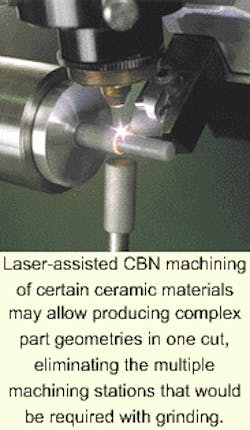By one estimate, the US market for ceramic components is somewhere around $10 billion. Further growth is limited, however, by the high cost of fabricating precision parts. While abrasive machining, or diamond grinding, remains the most common fabrication method for ceramic parts, high mechanical force and brittle fracture can often leave subsurface damage and cracks in machined components. When diamond tools are used, the technique also can account for more than 75% of the total cost of making a part. One reason is the roughly $1 million price tag for certain diamond grinding machines.
Although laser machining has been studied as a possible alternative, it can have problems meeting surface roughness requirements. A percentage of parts also have exhibited reduced flexural strength after processing. Lasers are not out for the count, though. Researchers at Purdue University (West Lafayette, IN) estimate that they may have a production-quality machine for laser-assisted cutting of ceramic materials in commercial use within a year. The technique developed by Yung Shin of Purdue's mechanical engineering department involves heating the material to be cut to more than 1000°C (1800°F) with a 1.5-kW CO2 laser to make the ceramic softer and more ductile (in many cases, 300 to 600 W of laser power was sufficient) and then removing the soft red-hot layer with a cubic boron nitride (CBN) cutting tool (see photo).
During their experiments, the researchers studied machining of two structural ceramics, silicon nitride (Si3N4) and partially stabilized zirconia (ZrO2). The first material has mechanical properties typical of a broad class of structural ceramics, the later one has a thermal expansion coefficient close to that of steels, making it a candidate for diesel engine parts. Machining parameters included a feedrate of 0.1-0.2 mm/rev for the CBN tool, a depth of cut of 0.5-1 mm, and cutting speed of 1-2 m/s. The test equipment was a conventional CNC lathe modified with a laser to heat the workpiece (the researchers also explored arc plasma heating for superalloy materials). A tri-axial dynamometer was used to monitor the cutting forces, a fiberoptic infrared pyrometer was developed and installed to monitor workpiece surface temperatures, and a PC-based data-acquisition system was incorporated for data collection and analysis.
Under the required machining conditions, including precision control of the laser beam and intensity, the laser-assisted machining equipment produced segmented chips as opposed to powder-type chips generated by grinding processes. Inspection under a scanning electron microscope revealed the chips to be relatively congruent and long, indicating plastic deformation. Shin says that his chip morphology has significance because it indicates that material removal is by a different mechanism in laser-assisted machining than in grinding. For example, specific cutting energy was roughly 6 J/mm3 compared to 40-100 J/mm3 typical with grinding. "Much lower mechanical energy is used to remove the material," he adds, "so the laser-assisted cutting process is less likely to induce subsurface damage."
Although earlier research indicated that laser-assisted machining would not be justifiable because of shortened tool life at elevated temperatures, Shin's research team found that the CBN inserts were slow to develop flank wear, and up to 40 min of tool life was possible under nominal cutting conditions.
Overall, Shin and colleagues believe the laser-assisted machining process experiments were successful in machining of both Si3N4 and ZrO2. Other possible ceramic candidates for the cutting process are those with sintering agencies such as glass, as well as metal matrix composites such as cermets.
Ongoing research by Shin and colleagues will include efforts to understand the details of how ceramics deform when subjected to high heat. "We are trying to understand what we call the therm-mechanical behavior of ceramics, and it's a very challenging issue," notes Shin.
About the Author
Paula Noaker Powell
Senior Editor, Laser Focus World
Paula Noaker Powell was a senior editor for Laser Focus World.
